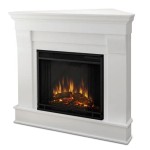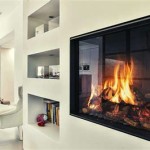Fireplace Mantel Color Ideas: A Comprehensive Guide
The fireplace mantel serves as a focal point in many homes, drawing attention and contributing significantly to the overall aesthetic of a room. Choosing the right color for the mantel is crucial for achieving a desired style, complementing existing décor, and creating a visually appealing space. This article examines various fireplace mantel color ideas, providing insights into selecting the most suitable option for diverse interior design schemes.
Selecting a mantel color requires careful consideration of several factors. The size of the room, the existing color palette, the architectural style of the house, and the desired mood all influence the final decision. A small room may benefit from a light-colored mantel to enhance the sense of spaciousness, while a large room can handle a bolder, darker hue. Similarly, the mantel color should harmonize with the surrounding walls, furniture, and flooring. Ultimately, the goal is to create a cohesive and balanced visual experience.
Understanding Color Psychology and its Impact on Mantel Color Selection
Color psychology plays a vital role in interior design, influencing emotions and perceptions. Different colors evoke distinct feelings and associations, which should be considered when choosing a mantel color. For example, warm colors like red, orange, and yellow are often associated with energy, warmth, and excitement. These colors can create a cozy and inviting atmosphere, particularly in living rooms or family spaces. However, they can also be overwhelming if used excessively, especially in smaller rooms.
Cool colors, such as blue, green, and purple, tend to evoke feelings of calmness, serenity, and sophistication. These colors can create a relaxing and peaceful ambiance, making them suitable for bedrooms or reading nooks. Lighter shades of cool colors can visually expand a space, while darker shades can add depth and drama. Neutral colors like white, gray, and beige offer versatility and can be easily incorporated into various design styles. They provide a blank canvas that allows other elements in the room, such as artwork or furniture, to take center stage.
Therefore, before selecting a specific color, consider the desired mood and atmosphere for the room. This understanding of color psychology can guide the decision-making process and ensure that the chosen mantel color contributes positively to the overall ambiance.
Exploring Different Color Schemes and Mantel Color Pairings
Several color schemes can be employed to create a visually harmonious and balanced interior. A monochromatic color scheme involves using different shades and tints of a single color. This approach can create a sophisticated and elegant look, particularly when using neutral colors like gray or beige. For a monochromatic mantel, one might choose a light gray for the walls and a slightly darker gray for the mantel, creating a subtle contrast.
A complementary color scheme utilizes colors that are opposite each other on the color wheel, such as blue and orange or red and green. This combination creates a vibrant and energetic contrast. When using a complementary color scheme for a fireplace mantel, it's essential to balance the intensity of the colors. For instance, pairing a deep blue wall with a muted orange mantel can create a striking yet balanced effect.
An analogous color scheme involves using colors that are adjacent to each other on the color wheel, such as blue, blue-green, and green. This combination creates a harmonious and soothing effect. An analogous mantel color scheme could involve painting the walls a light blue and the mantel a slightly darker shade of blue-green. The use of neutral accents can help to break up the color scheme and add visual interest.
Choosing a neutral mantel color, such as white, gray, or beige, offers versatility and allows for experimentation with different color schemes in the surrounding space. A white mantel, for example, can complement virtually any wall color and can be easily updated with seasonal décor or accessories. The key is to consider the overall color scheme and choose a mantel color that enhances the visual appeal of the room.
Material and Finish Considerations for Fireplace Mantel Color
The material of the fireplace mantel significantly impacts the appearance and durability of the chosen color. Different materials absorb and reflect light differently, affecting the perceived shade of the color. For example, a painted wooden mantel will have a different appearance than a stained wooden mantel or a stone mantel.
Wooden mantels offer a wide range of color options, from natural stains to painted finishes. Stains enhance the natural grain of the wood and can create a rustic or traditional look. Painted finishes, on the other hand, provide a more uniform and modern appearance. When painting a wooden mantel, it’s essential to use a high-quality primer and paint to ensure proper adhesion and durability. The finish, whether matte, satin, or gloss, also affects the appearance of the color. Matte finishes tend to absorb light and create a softer, more understated look, while gloss finishes reflect light and create a more dramatic and polished appearance.
Stone mantels, such as those made from granite, marble, or limestone, typically have a natural color that is determined by the type of stone. These mantels can be sealed to enhance their natural color and protect them from stains and damage. While staining is less common for stone mantels, certain types of stone can be treated to alter their color slightly. When choosing a stone mantel, it's important to consider the natural variations in color and texture, as these can significantly impact the overall aesthetic.
Metal mantels, such as those made from wrought iron or steel, offer a sleek and modern look. These mantels can be painted or powder-coated in a variety of colors. Powder coating provides a durable and long-lasting finish that is resistant to scratches and chips. When choosing a color for a metal mantel, it's important to consider the overall style of the room and the existing metal accents. For example, a black metal mantel can complement industrial or contemporary designs, while a brass or copper mantel can add warmth and elegance to a more traditional space.
The texture of the mantel also influences the perceived color. A rough, textured surface will absorb more light than a smooth surface, making the color appear darker. Conversely, a smooth, polished surface will reflect more light, making the color appear lighter. Consider these factors when selecting both the material and the finish for the fireplace mantel to achieve the desired aesthetic.
Ultimately, the ideal fireplace mantel color should complement the overall design scheme of the room, enhance its architectural features, and create a welcoming and visually appealing focal point. Careful consideration of color psychology, color schemes, material, and finish will contribute to a successful outcome.

Mantel Makeover With Paint

Paint Color Picks For Magnificent Mantels Tinted Sherwin Williams
:max_bytes(150000):strip_icc()/208368922_866049550648380_5600741727305574454_n-533ffc956ce04a8eaa7c81d2f7eb1fdd.jpg?strip=all)
30 Gorgeous Painted Fireplace Ideas

The Fireplace Surround Is Painted In Sherwin Williams Gauntlet Gray Remodel Farmhouse Decor Home

Live Beautifully Before After A Beautiful Kitchen Home Fireplace Living Room

Painted Fireplace Mantels Add Zz

How To Paint Your Mantel And Get Clean Lines Postcards From The Ridge

10 Fireplace Mantel Decorating Ideas Full Service Chimney

Fireplace Design Ideas Materials Colors Styles In 2024 Bodaq

50 Cozy Fireplace Ideas Best Mantel Decor
Related Posts








